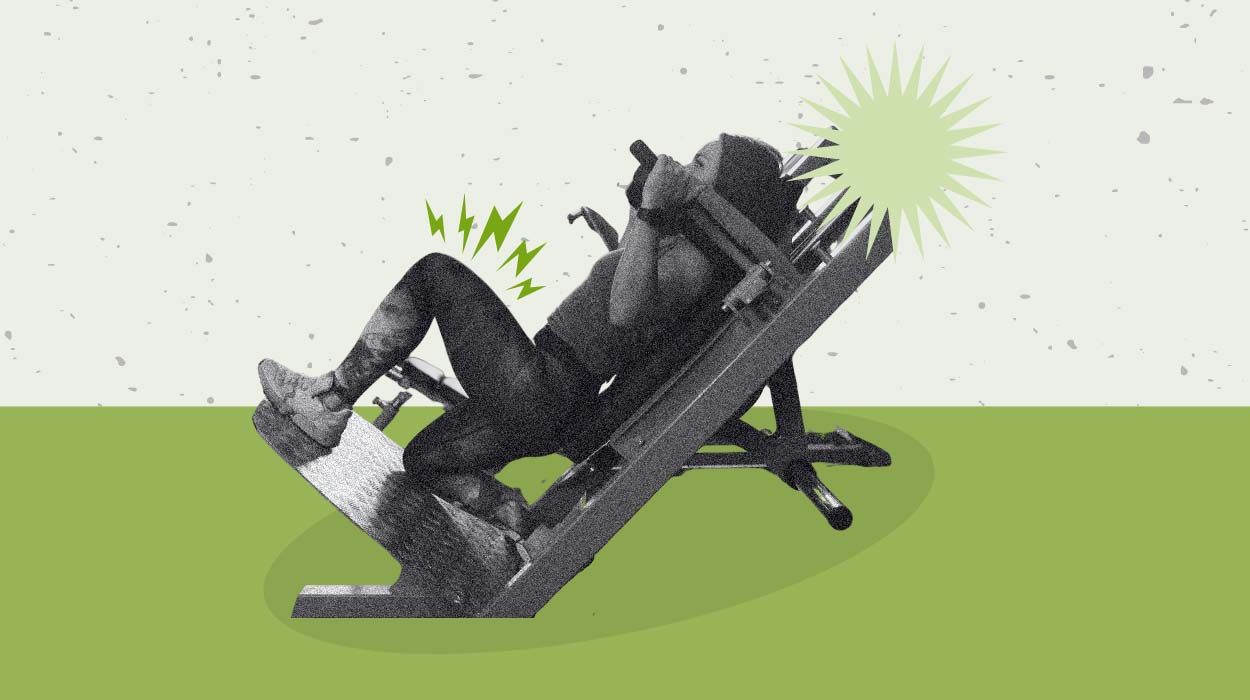
The hack squat has gained significant popularity over the past years. Also called a “rear deadlift,” this squat variation is performed by holding the barbell behind the back with an upright torso. Doing so makes this squat a fantastic quad exercise and easy on the back. The problem is that it is pretty awkward to perform.
So is that it? Do we just have to deal with the awkwardness to get the benefits? Not at all! We have found the best hack squat alternative to give your quads an intense workout without awkward positioning.
Hack Squat Alternatives
Before we get into the details, let’s take a quick peek at the eight different hack squat alternatives we’ll see in this article.
Each of the above exercises carries their benefits which make them the ideal choice for various situations. Strength training? Muscle growth? Have an injury? Whatever your circumstances, we can promise one of them we’ll get the job done.
Hack Squat Alternative
Now that we’ve gone over what a hack squat is and what makes a good alternative, it is time to reveal the eight best exercises to use in place of the hack squat.
Machine Hack Squat
The problem with the free-weight version is that it is simply awkward. That’s what makes hack squat machine alternatives so awesome!
Using hack squat machines takes away all the awkwardness of lifting a barbell behind the back but leaves you with all the benefits. Plus, it supports your back even further if this is a concern for you. But be warned, these will destroy your quads!
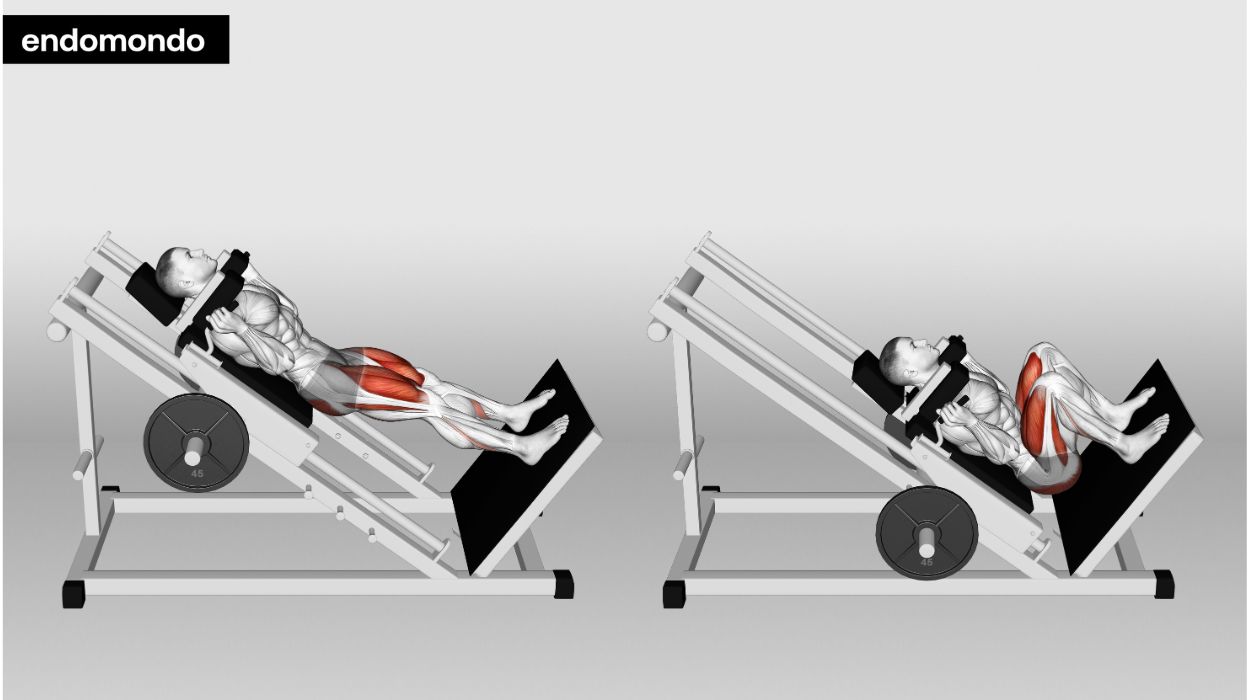
How to do:
- Position feet shoulder-width apart on the machine platform.
- Align shoulders under pads, maintaining a straight back posture.
- Bend knees, lower into a squat, keeping core engaged.
- Descend until your thighs are parallel to the platform.
- Push through heels to return to the starting position.
Tips:
- Keep your back straight and aligned with your neck to prevent strain.
- Focus on distributing your weight evenly across both feet to enhance stability and effectiveness.
- Lower yourself slowly and rise at a controlled pace to maximize muscle engagement and reduce injury risk.
Optimal Sets and Reps: 3-4 sets of 8-10 repetitions each.
Front Squat
The front squat is a terrific choice for an alternative to the barbell hack squat. As the name implies, the barbell rests on the front of the body as you squat, specifically on the anterior deltoids. As a result, the torso must remain upright to keep the barbell from falling off or the entire body from falling over.
The body position of the front squat and hack squat are very similar. As such, the front squat is much less stressful on the lower back.
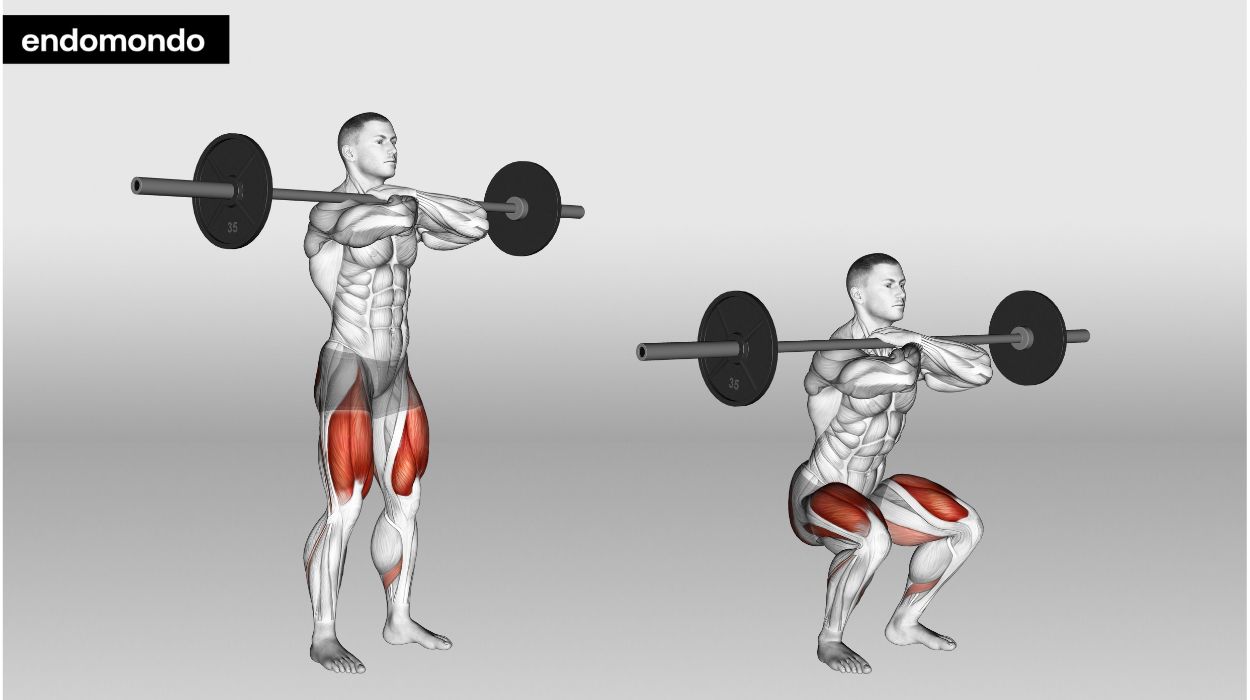
How to do:
- Start with feet shoulder-width apart, toes slightly outward.
- Position barbell across front shoulders, elbows up.
- Keep the spine neutral, and engage the core throughout the movement.
- Lower into a squat, hips back, knees aligned with toes.
- Push through heels to return to the starting position.
Tips:
- Keep elbows high and pointing forward throughout the exercise to maintain the barbell’s position and balance.
- Aim for squatting down until your thighs are at least parallel to the ground, ensuring your heels stay flat.
- Breathe in on the way down and exhale as you push up, to stabilize your core and maintain a steady rhythm.
Optimal Sets and Reps: 3-4 sets with 6-8 repetitions each.
Sissy Squat
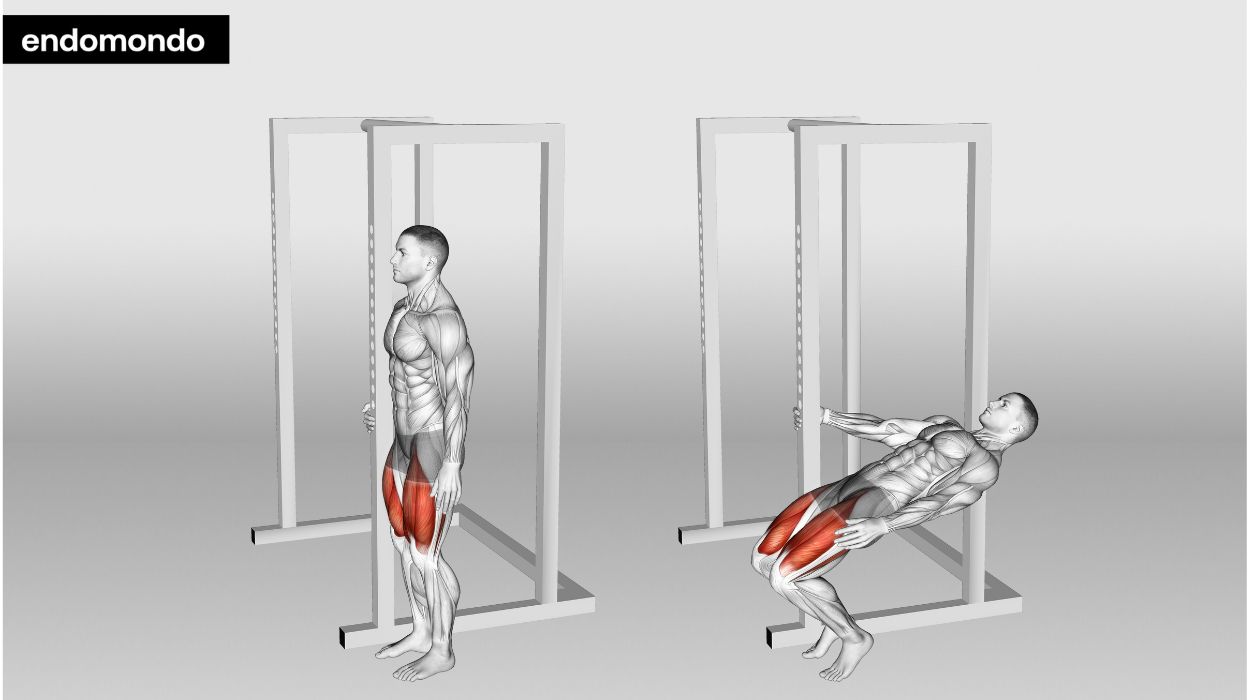
Sissy squats are the only bodyweight exercise on this list, but don’t let the name fool you into thinking they are easy. They require a great deal of strength and mobility before even being attempted.
This position requires you to only use your quads to lift the entire body. In addition, the added torque created only adds to the load. These are extremely tough but will give your quads an insane workout.
How to do:
- Stand upright, feet hip-width apart, toes pointing forward, and hold onto a sturdy surface with one hand.
- Lean back slightly, keeping legs straight and core engaged.
- Slowly bend your knees, lowering your torso backward and upward.
- Lower down until thighs are near parallel to the ground.
- Return to a standing position by straightening your knees, and maintaining balance.
Tips:
- Keep your quads engaged throughout the entire movement to maximize muscle activation and prevent injury.
- Perform the movement slowly and with control, avoiding jerky or rapid motions to ensure safety and effectiveness.
- Initially, use a pole or wall for balance until you develop the strength and balance required for the exercise.
Optimal Sets and Reps: 3-4 sets of 8-12 repetitions each.
Plie Squat
The Plie Squat is a lower body exercise targeting the glutes, thighs, and calves. Performed with feet wider than shoulder-width and toes pointed outward, it involves bending the knees to lower the body, then rising back up. It emphasizes inner thigh and glute engagement, improving flexibility and balance.
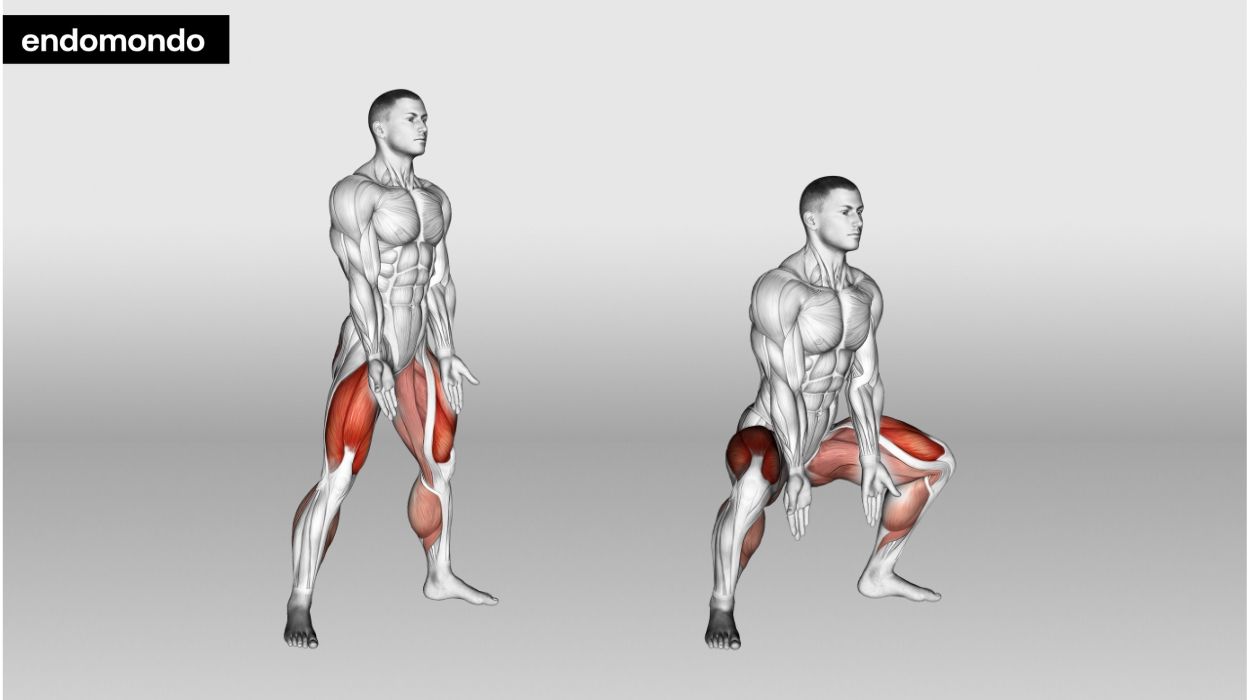
How to do:
- Stand with feet wider than shoulder-width, toes pointing outward.
- Keep spine straight, shoulders relaxed, and core engaged.
- Slowly bend your knees, lowering your hips towards the ground.
- Go down until your thighs are parallel to the floor.
- Push through heels to return to the starting position.
Tips:
- Focus on knee alignment: Ensure your knees are aligned with your toes throughout the movement to prevent joint strain.
- Depth control: Lower yourself until your thighs are parallel to the floor, but avoid going too deep to maintain form.
- Engage your glutes: Actively engage your glutes and inner thighs as you rise to maximize the exercise’s effectiveness.
Optimal Sets and Reps: 3-4 sets of 10-12 repetitions each.
Goblet Squat
Goblet squats have similar biomechanics to the plie squat and are just as awesome.
The Goblet Squat is a full-body exercise focusing on the lower body. Holding a dumbbell or kettlebell close to the chest, the practitioner performs a squat, keeping the weight stable. This exercise enhances strength, improves balance, and engages the core, glutes, quads, and inner thighs.
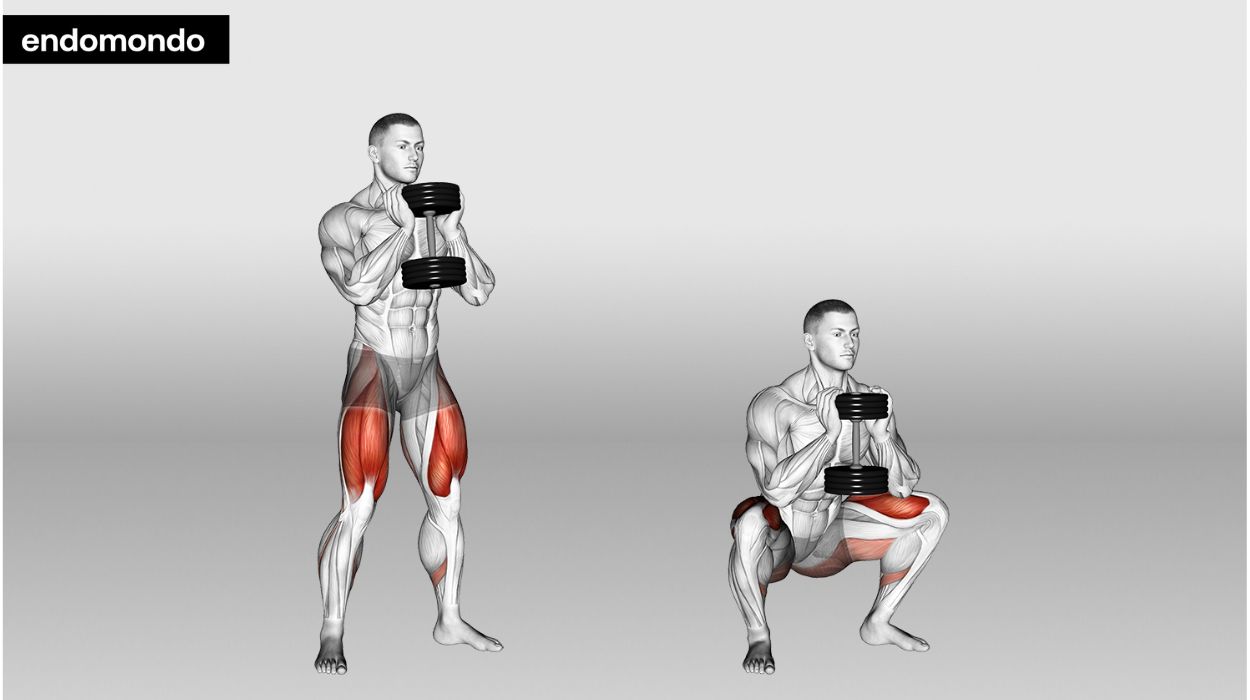
How to do:
- Stand with feet shoulder-width apart, knees slightly bent.
- Hold a dumbbell at chest level, palms cupping each end.
- Position the dumbbell on the upper chest, and elbows on the center belly.
- Lower into a squat, keeping the dumbbell stable on the chest.
- Rise back up, maintaining the dumbbell’s position and form.
Tips:
- Keep your chest up and eyes forward to maintain an upright posture, ensuring the weight doesn’t pull you forward.
- Press through your heels when rising from the squat to activate your glutes and hamstrings more effectively.
- Breathe deeply, inhaling as you lower down and exhaling as you rise, to maintain core stability and rhythm.
Optimal Sets and Reps: 3-4 sets of 8-12 repetitions each.
Belt Squat Machine
Instead of a barbell or dumbbell, the belt squat machine uses a pulley system that attaches a weight to a belt worn around the waist. As the weight is attached to the waist, there is virtually no stress on the back. Most machines also come with handles to help with stability.
The lifter can then perform movements of their choice with relative freedom. To more closely replicate the hack squat, follow similar cues to the front squat. And remember, keep your torso up and straight!
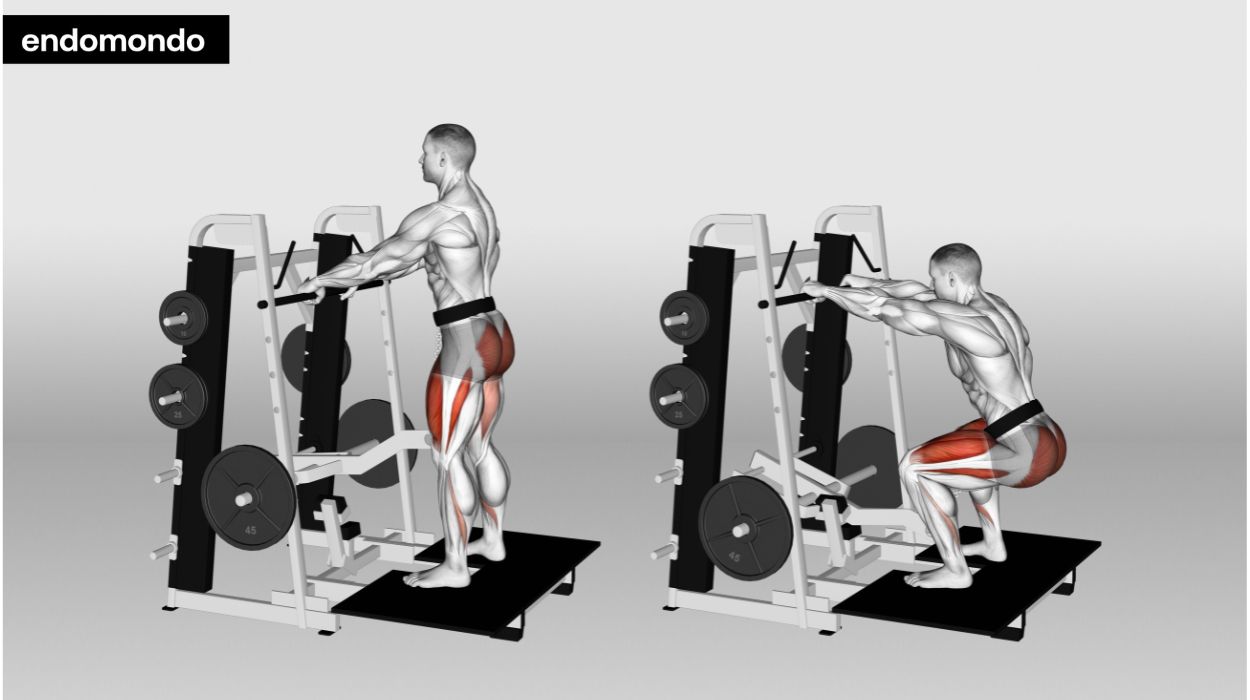
How to do:
- Step onto the machine platform, positioning feet shoulder-width apart.
- The secure belt around the waist, adjusting for snug fit.
- Stand upright, engaging your core and maintaining a straight back.
- Lower into a squat, bending knees, hips back, chest up.
- Push through heels to return to the starting position.
Tips:
- Ensure your knees are tracking over your toes during the squat to prevent knee strain and ensure proper alignment.
- Lower yourself slowly and with control, pausing briefly at the bottom, to maximize muscle engagement and improve strength.
- Keep your chest up and shoulders back throughout the exercise to reduce the risk of back strain and improve posture.
Optimal Sets and Reps: 3-4 sets of 8-12 repetitions each.
Safety Bar Squat
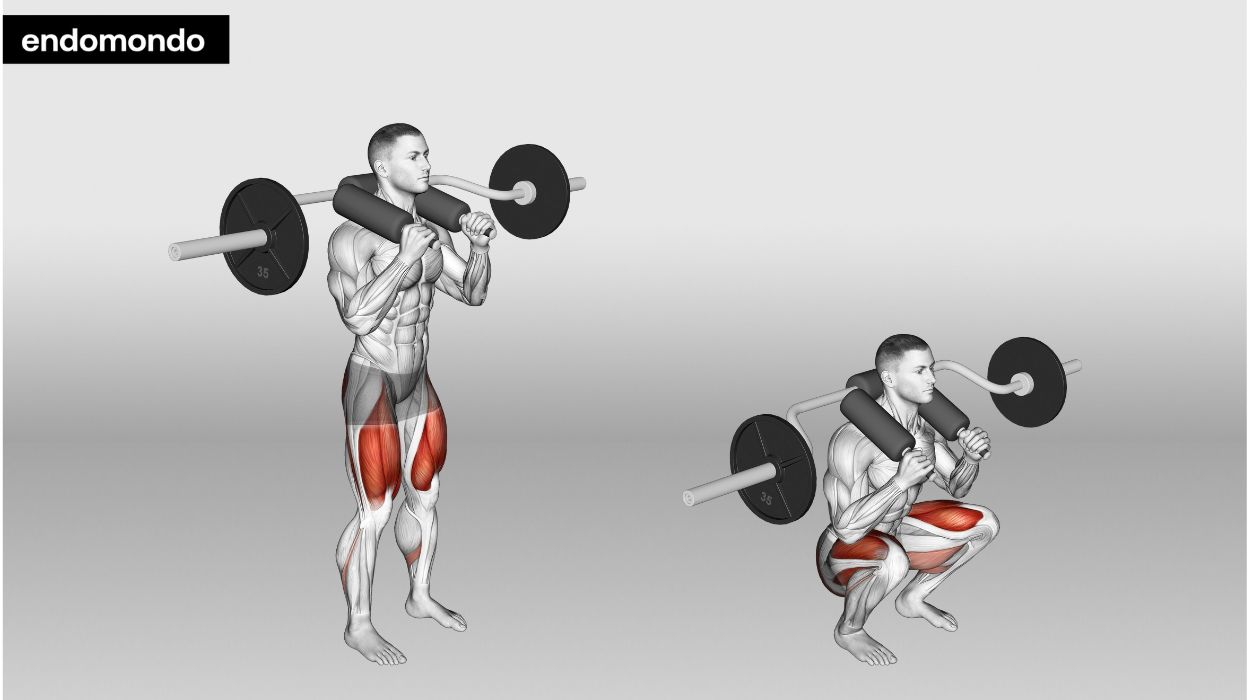
The safety bar squat is one of our favorite squat variations. Though it has been primarily used by strength athletes in the past, the general public has more recently become aware of this awesome workout.
The safety squat bar uses a unique design that places the weight on your upper back with two heavily padded handles in front of the body. Grabbing the handles secures the weight and allows you to sit upright with zero fear of the weight falling. Studies have shown[1] that using a safety squat bar takes stress from both the posterior muscles and the torso.
Using the safety bar squat allows you to continue training when you feel your back may need a break. Or, it can give you the confidence to put in more volume knowing you’re taking a lot of the stress off your back.
How to do:
- Position the safety bar on the shoulders, gripping handles for stability.
- Stand with feet shoulder-width apart, toes slightly outward.
- Keep head up, back straight, and core engaged.
- Lower into a squat, keeping knees in line with toes.
- Drive through heels to return to the starting position.
Tips:
- Keep your elbows down and close to your body to maintain balance and control of the safety bar.
- Aim to lower yourself until your thighs are parallel to the ground, ensuring your heels stay flat and your back remains neutral.
- Inhale on the way down and exhale as you push up, to stabilize your core and maintain a steady rhythm.
Optimal Sets and Reps: 3-4 sets of 6-8 reps each.
Hatfield Squat
The Hatfield squat comes from Dr. Hatfield, an elite powerlifter known for his massive quads. During the off-season, he wanted a squat that would focus on his quadriceps while giving his back relief during the off-season. After some experimenting, he developed the Hatfield squat.
The Hatfield squat requires a safety squat bar as well as one other barbell.
How to do:
- Set safety squat bar on shoulders, gripping support handles.
- Stand with feet shoulder-width apart, toes pointed slightly out.
- Keep head up, back straight, and core tight.
- Lower into a squat, maintaining balance and control.
- Push through heels, returning to the starting position.
Tips:
- Grip the handles of the squat rack for added stability and to assist in maintaining an upright posture.
- Lower yourself slowly and rise at a controlled pace, focusing on keeping your weight distributed evenly across your feet.
- Tighten your abdominal muscles throughout the exercise to support your lower back and improve balance.
Optimal Sets and Reps: 3-4 sets of 8-10 repetitions each.
What Is A Hack Squat?
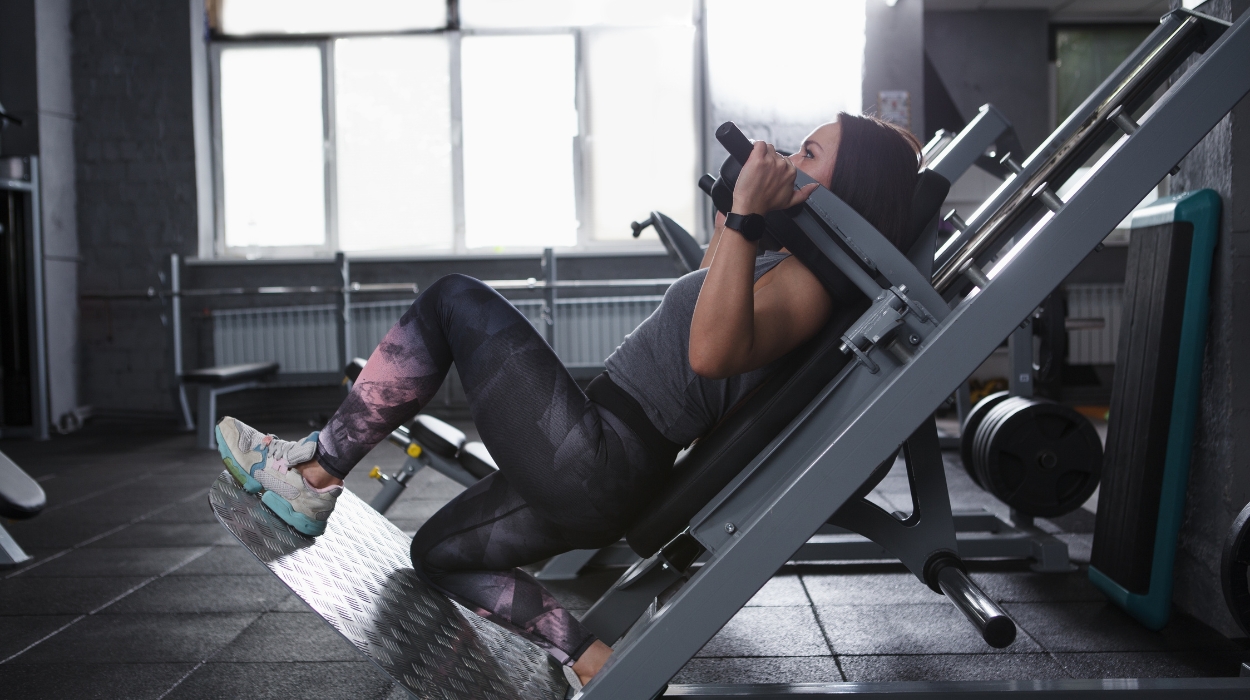
To get into the best alternatives for hack squats, we have to answer the question: What is the hack squat? The hack squat is a free-weight exercise that uses a barbell to perform a squat variation. It’s performed by lifting a barbell from the ground from behind your back. This is why it’s also sometimes called a rear deadlift.
Due to the biomechanics, the lifter will find their torso much more upright. There’s also less flexion in the hips and more flexion in the knees. As a result, hack squats place significantly more load on the quadriceps. In addition, studies have found[2] that it places significantly less stress on the torso which is a pro or a con depending on your goal.
What Makes A Good Hack Squat Alternative?

Not just any lower body movement can be a hack squat alternative. There are a few key variables needed for an exercise to qualify for this position, so let’s get into what you need to look for.
Upright Torso Position
The first key to an excellent hack squat alternative is a movement that promotes an upright torso. This provides two benefits:
- Places less stress on the back.
- Minimizes hip extension (mitigates the use of hamstrings).
Quadricep Specific
The minimal hip extension will minimize the use of the hamstrings. Since the hack squat has traditionally been focused on the quadriceps muscle, any alternative will need to have the same focus. This is exactly why it was invented in the first place.
Compound Exercise With Heavy Loads
While the quads are indeed the focus, an alternative to hack squats cannot be an isolation exercise of only the quads. The hack squat is a compound, free-weight exercise that can lift heavy loads. As a result, you need an excellent compound exercise that will allow high-intensity lifts of heavyweight.
Conclusion
The hack squat is a fantastic, quad-focused exercise that fulfills an important need in any workout regimen. That being said, having some other options may prove useful when it comes to continual progression. Narrowed down to eight of the best alternatives, you are now ready to implement one (or two, or three) into your next training session!
Frequently Asked Questions
Due to the upright torso and less hip flexion, the hack squat primarily works the quads.
Compound exercises that are quad dominant, such as front squats and goblet squats.
You perform what’s essentially a deadlift behind your back.
Resources
- Hecker, K.A., Carlson, L.A. and Lawrence, M.A. (2019). Effects of the Safety Squat Bar on Trunk and Lower-Body Mechanics During a Back Squat. PubMed, [online] 33(1), pp.S45–S51. doi:https://doi.org/10.1519/jsc.0000000000002912.
- Clark, D.R., Lambert, M. and Hunter, A.M. (2019). Trunk Muscle Activation in the Back and Hack Squat at the Same Relative Loads. The Journal of Strength and Conditioning Research, [online] 33(1), pp.S60–S69. doi:https://doi.org/10.1519/jsc.0000000000002144.




